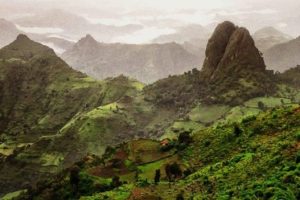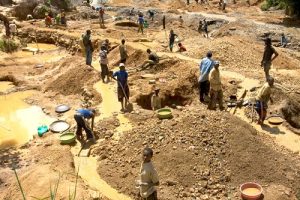
BY STAFF REPORTER
Satellite data show that undisturbed forests will completely disappear in large tropical humid regions by 2050 under current disturbance rates, according to new research.
Similarly, Ethiopia has been losing about 92,000 ha (0.54 per cent) of forest annually between 2000 and 2013 (Ethiopia’s FRL, 2016). It has historically lost most of its forest cover in the north and central areas from various forces, and these areas now require large scale restoration. Yet it indicates that the rate of afforestation is only a fifth of the rate of loss.
Deforestation and forest degradation are caused by both direct and underlying factors. Hence there is a critical need for continuous awareness creation on the positive and transformational impacts of forests in various sectors of the Ethiopian economy and ensuring its sustainability to the leadership and law makers. This would eventually lead to recognition of forestry as a pillar of our development strategy.
Forests play a key role in stabilizing the environment; their carbon-storage capacity offering a nature-based solution to climate change by keeping the release of planet-warming greenhouse gases in check.
In a new analysis of the patterns of deforestation and forest degradation caused by human activities over the past 30 years, scientists now estimate that almost 219 million hectares or 17 percent of tropical moist forests have disappeared. Of the remaining 1.07 billion hectares of tropical moist forests, 10 percent are degraded, generally an indicator that deforestation will follow, scientists said in a study published in Science Advances.
“In more than 45 percent of cases, if action had been taken to prevent degradation, forest clearance – which occurred on average after 7.5 years – would have been prevented, said Christelle Vancutsem, a specialist in remote sensing and lead author of the study, who worked alongside a team of scientists from the European Commission Joint Research Center, the Center for International Forestry Research (CIFOR), France’s Agricultural Research for Development center (CIRAD) and Brazil’s National Institute for Space Research (INPE).
To reach their findings, the researchers mapped land cover changes from 1990 to 2019 using Landsat images to observe how forest landscapes varied and changed over time, noting when they were undisturbed, degraded, regrown, deforested, afforested or converted to plantations or water. The scientists also noted the dates and duration, recurrence and intensity of each disturbance.
Understanding disturbance patterns can help countries work toward meeting targets for the U.N. Sustainable Development Goals and their Nationally Determined Contributions, which are a key reporting component under the U.N. Paris Agreement strategy to prevent post-industrial average temperatures from rising to 1.5 degrees Celsius or higher.
“It’s now possible to monitor deforestation and degradation in tropical moist forests consistently over a long historical period and at fine spatial resolution,” Vancutsem said. “Mapping forest transition stages will make it possible to derive more targeted indicators to measure achievements in forest, biodiversity, health, and climate policy goals.”
The results reveal the pressing need to reinforce actions for preserving tropical forests, in particular, by avoiding the initial degradation that most likely leads to subsequent forest clearance, she added.
Recognizing that no ecosystem can be considered truly undisturbed, the scientists defined forest degradation as a disturbance in the tree cover canopy visible from space over a period of less than 2.5 years, which leads to loss of biodiversity or carbon storage – or both.
Their research also shows that trends in deforestation rates seem to be tied to national territorial policy changes, Vancutsem said. On the other hand, degradation rates are closely connected to climate conditions and are unaffected by forest conservation policies. The situation seems to be accelerating, she added. “Over the five years from 2015 to 2019, we saw a significant increase in forest degradation: an additional 2.6 million hectares in relation to the period 2010-2014.”
This trend is explained by specific climate conditions, specifically droughts and fires associated with the El Niño effect of 2015-2016. Deforestation and forest degradation are major threats to the climate and biodiversity.
“The conversion of forests to agricultural uses is the second largest source of atmospheric CO2 emissions after fossil fuel combustion,” said Ghislain Vieilledent, co-author of the study and an ecologist at CIRAD.
We understand from the results that it is of paramount importance to integrate measures that reduce degradation in forest conservation and climate mitigation programs, Vancutsem added. They also show that forest degradation must be considered as a risk factor of deforestation and as an indicator of climate change and climate oscillations.
“We expect that improved knowledge of forest degradation processes and the resulting fragmentation will help to make accurate assessments of the human impact on tropical ecosystem services and their impact on biosphere-atmosphere-hydrosphere feedbacks,” she said. “The research indicates that future land management policies will have to account for this finding.”
The data also show that 41 percent of pantropical degraded forests are in Asia-Oceania, almost 40 percent in Latin America and a little over 22 percent in Africa. 32 percent of deforested areas in tropical moist forests are in Asia-Oceania, 47 percent in Latin America and 21 percent are in Africa.
The scientists also learned that the distribution of – which is defined as tree cover regrowth after a full removal of tree cover that remained without regrowing trees for at least 2.5 years – is 46 percent in Asia-Oceania, 43 percent in Latin America and 11 percent in Africa.
“We can confirm that most deforestation caused by oil palm and rubber expansion and assigned to the commodity classes in our study is concentrated in Asia,” Vancutsem said. “This is equal to more than 18 million hectares, representing 86 percent of the entire tropical moist forest conversion to plantations — specifically more than 57 percent in Indonesia and more than 23 percent in Malaysia.”
The Ethiopian Herald April 14/2021





